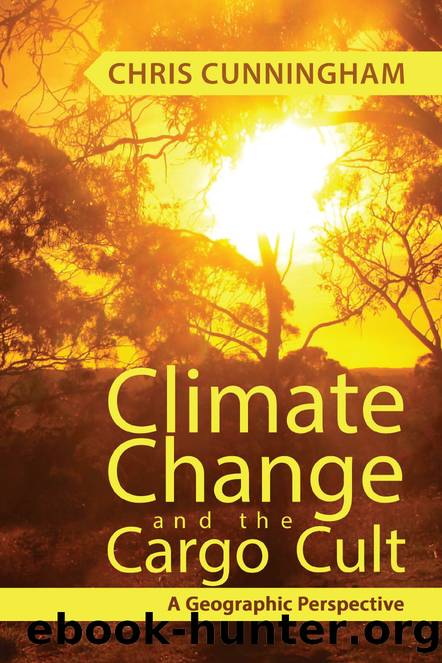Climate Change And The Cargo Cult by Cunningham Chris;

Author:Cunningham, Chris;
Language: eng
Format: epub
Publisher: Austin Macauley Publishers
Published: 2019-01-31T00:00:00+00:00
The gradual and evolutionary nature of climate change
Most of the physical consequences of climate change are unlikely to be dramatic in the way that they evolve from that change. They are more likely to be evident in analysis of weather statistics than apparent to the casual observer in the street (or paddock!). Rainfall in the North would likely increase on average, but would also be more irregular. Coastal towns and farms northward of Sydney, already affected by not infrequent flooding, could expect somewhat more flood events and a higher frequency of major floods with considerable community damage and disruption. Such events would hardly be unprecedented but may well occur more often.
In the South, rainfall would decrease, and agriculture would ebb southwards and be less intensive. At any given time, people are unlikely to detect the changes as they affect their daily lives, but over the course of decades, changing climate will impact on regional livelihoods. It would still rain, be fine, thunder, hail, be hot, be cool and be cloudy: each pattern returning in its inimitable and irregular way. No single event â be it floods, drought, frost, bushfire blow-up day, or tropical cyclone could ever be firmly attributed to âglobal climate changeâ â we have seen them all before and will see them again but perhaps with a rather altered and increased frequency of occurrence. Sea level rise, should it occur, will affect relatively small areas that are already well-known for the resistance of residents to recognise that their assets, with their treasured coastal or river frontage, are built on land which is geomorphically unstable because of the threat of storm surge or coastal erosion. Climate change does not generally introduce new problems here but it does intensify old ones.
Climate change notwithstanding, coastal erosion, flood or bushfire damage mitigation through policy rather than through expensive engineering works has been a thorny problem for insurance companies and governments. Occupants of waterfront property threatened by coastal erosion refuse to concede the risks their situation involves â even in the absence of climate change. Attempts to define likely limits for serious floods, with different levels of probable return frequency, have been met with protest and opposition in the community as property owners within the defined zones fear devaluation of their property21.
After the southern Queensland floods of 2009-2010, Insurance companies were castigated by the popular press and not a few politicians for refusing cover to property owners in flood-liable areas. The upshot has been a grudging concession of cover in flood-liable areas, as well as some bizarre definitions of same to balance of risk 22, combined with steeply rising premiums for all policy holders. In parallel with this hesitancy to deal with adaptation to floods by policy, there is general and long-standing policy inertia against limiting urban settlement in bushfire-prone areas.
Indeed, in all of the debate about climate change, very little attention is given to adaptation strategies such as insurance or planning regulation which put a cost and obligation onto individuals to adapt their plans to the likelihood of increased climatic risk.
Download
This site does not store any files on its server. We only index and link to content provided by other sites. Please contact the content providers to delete copyright contents if any and email us, we'll remove relevant links or contents immediately.
How to Do Nothing by Jenny Odell(2669)
A Forest Journey by John Perlin(2608)
The Plant Messiah by Carlos Magdalena(2476)
Babylon's Ark by Lawrence Anthony(2094)
Energy Myths and Realities by Vaclav Smil(2084)
The ESV Study Bible by Crossway Bibles(2041)
Abbey in America by Murray John A(1822)
Fatal Storm by Rob Mundle(1802)
Witness Tree by Lynda V. Mapes(1705)
Shadows on the Gulf by Rowan Jacobsen(1528)
Client Earth by James Thornton(1520)
Brokeback Mountain by Annie Proulx(1486)
Coming Back to Life by Joanna Macy(1480)
Water Rights and the Environment in the United States by John Burch(1427)
Cosmos by Carl Sagan(1419)
Ten Billion by Stephen Emmott(1395)
Mycelium Running: How Mushrooms Can Help Save the World by Paul Stamets(1308)
The overachievers by Robbins Alexandra(1296)
The Uninhabitable Earth by David Wallace-Wells;(1205)
